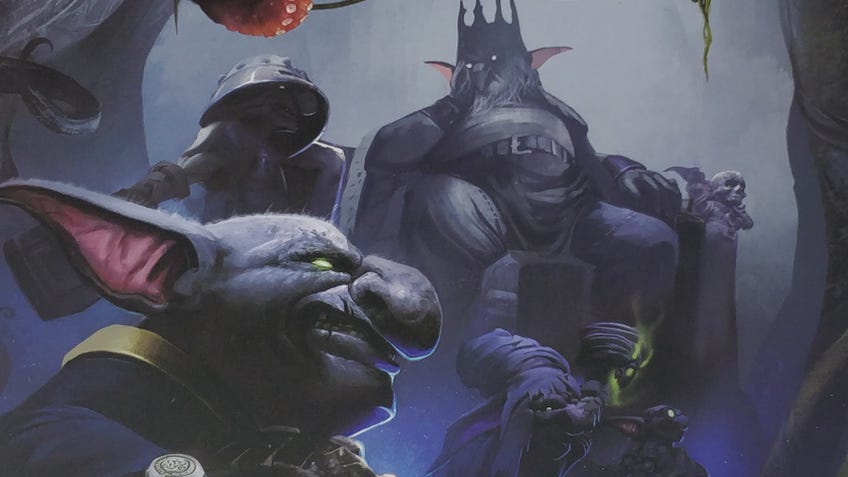Miremarsh board game review - darkly comic goblin adventure makes failure fun
So long and thanks for all the fish.
When I first saw the box for Miremarsh I felt decidedly uninspired - aside from the inclusion of goblins - because for all intents and purposes it looked like your bog (ha, ha) standard dungeon-crawler. It’s hard to get excited about the monster-bashing genre when it feels like a hopeful but ultimately hackneyed newcomer stuffed full of miniatures pops up on Kickstarter every day.
The drab box art and cliche tagline - ‘A game of evil deeds, death and tentacles’ - certainly doesn’t help Miremarsh stand out from its dungeon-crawling peers either, at least not initially. But look beyond the cover and you’ll actually find a surprisingly comedic game that isn’t afraid to make jokes about, of all things, death.
Miremarsh is a board game where you primarily explore different areas of a swamp on the hunt for loot, so that your goblin has a better chance at completing one of four possible quests and winning the game. The game’s board is constructed from a randomly-selected series of tiles offering different levels of difficulty - the fourth-level tiles being the ones to hold those all important quests.
Goblins can die very easily in Miremarsh, but players have the opportunity to start again with a new character every time they do, except for those instances wherein permadeath occurs. (We’ll get to that later.) All of these elements makes it easy to compare Miremarsh to a roguelike video game, with its heavy emphasis on replayability, random exploration and permanent character death.
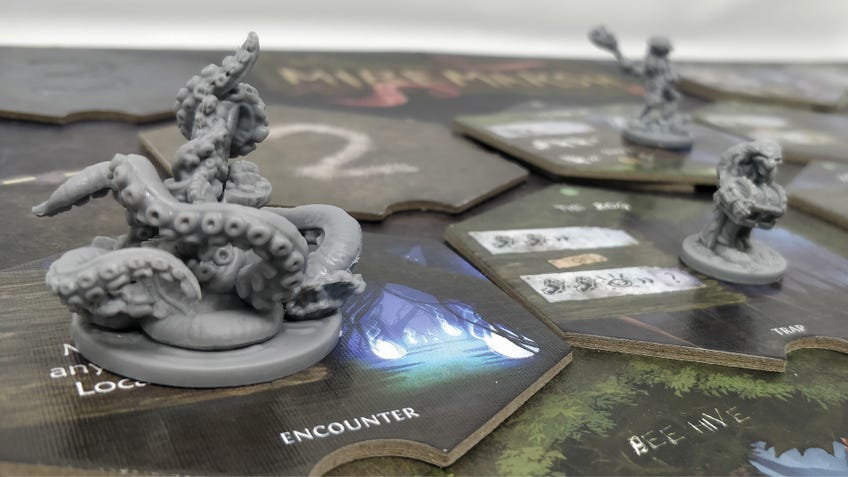
You might begin the game controlling a single goblin but you’ll likely end up making your way through at least one - if not more - gobbos by the end. Then again, maybe you won’t; I’ve played games where my starting goblin has made it all the way through to victory. This is the real hook of Miremarsh: it’s predictably unpredictable.
Each turn of Miremarsh begins in the same fashion, with the current player rolling their pool of custom dice until they successfully roll a foot symbol, which allows them to move to an adjacent tile. Once a player has rolled they can decide where (or if) they want to move, with any undiscovered tiles needing to be flipped before a player can move there. Exploring an undiscovered tile evokes the feeling of venturing into the unknown, helping the initial turns of Miremarsh create a compelling atmosphere of fear and excitement - your goblin is weak and the dangers of the swamp are great.
You might begin the game controlling a single goblin but you’ll likely end up making your way through at least one - if not more - gobbos by the end.
Any newly-flipped tile has a chance of containing a compulsory challenge, which needs to be completed before the player can do anything else. Challenges are overcome using the player’s available dice pool and any other buffs or items they have on hand, which is where the act of hunting for loot and buying things really pays off. Each test requires players to fulfill a quota of symbols using their freshly-rolled dice. For example, a trap challenge might need two foot symbols and one eye icon to be completed. The probability of rolling each combination of symbols is entirely dependent on the colour of the dice being rolled, with the different colours indicating the likelihood of certain symbols being rolled. There are four die colours in Miremarsh - green, black, yellow and blue - with each goblin starting with a unique combination. Acquiring dice tokens by completing challenges, buying them from trade tiles or getting them in encounters enables players to add to their existing dice pool and improve their chances of rolling certain symbols.
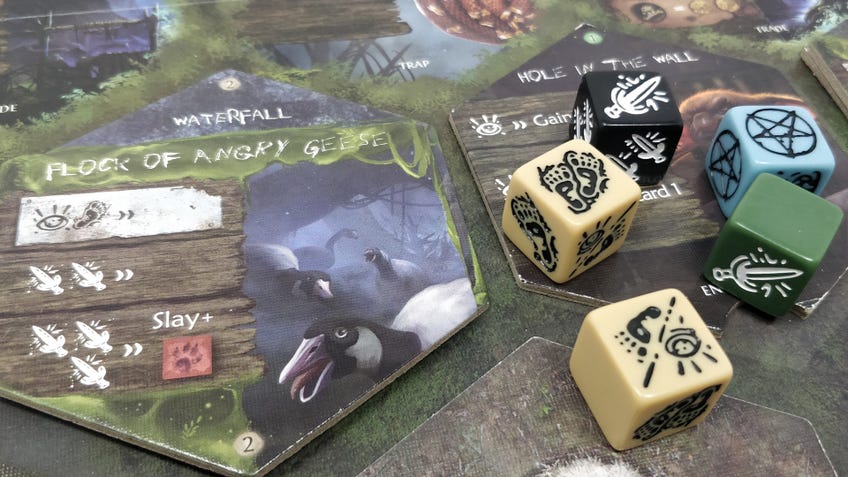
However, this means that if a player stumbles across a compulsory challenge requiring a symbol their current pool of dice doesn’t have, their goblin automatically dies. Considering that dice need to be spent in order to move as well as complete challenges, and any rerolls must be done using all remaining dice with no opportunities for locking any useful results, this initially came across as unreasonably unfair in my first few playthroughs. Fail any challenge - even those with no reward - and it’s instant death. No ifs, no buts. However, the harshness of the rolling is quickly softened by ease of starting again with a fresh goblin. There is a penalty to dying - you have to discard all the loot you’ve collected up to this point, which can hurt if you’ve gotten your hands on a powerful spell or loads of additional dice - but rebuilding your goblin’s capabilities doesn’t take long and, in some cases, can be easier with a different character that has access to a different set of starting dice, items and abilities.
Any time someone began to get too complacent, the ever-present spectre of death would loom once again and shake up the game’s state.
Deciding which quest to pursue is influenced by your current goblin’s available dice pool, as quests are a final gauntlet of three compulsory challenges that may require a large amount of the same symbol - meaning players will have to horde certain colours of dice - payments of gold or bones, or players needing to discard a particular amount of items. Working towards these quests is crucial because they’re the main way you win the game - the other requires you to be the last goblin standing, and doesn’t feel nearly as rewarding - but a goblin death can dramatically change your strategy. If you were originally working towards a quest that required you to roll a certain amount of feet and your current goblin dies, your next goblin’s dice pool might favour dagger symbols instead - forcing you to rethink how you’re going to approach the goal of winning.
I love this about Miremarsh. It helps keep the game dynamic, stopping it from ever growing stale. Any time someone began to get too complacent, the ever-present spectre of death would loom once again and shake up the game’s state, giving players who might be on the back foot an opportunity to get ahead and potentially offering other players a new path towards victory.
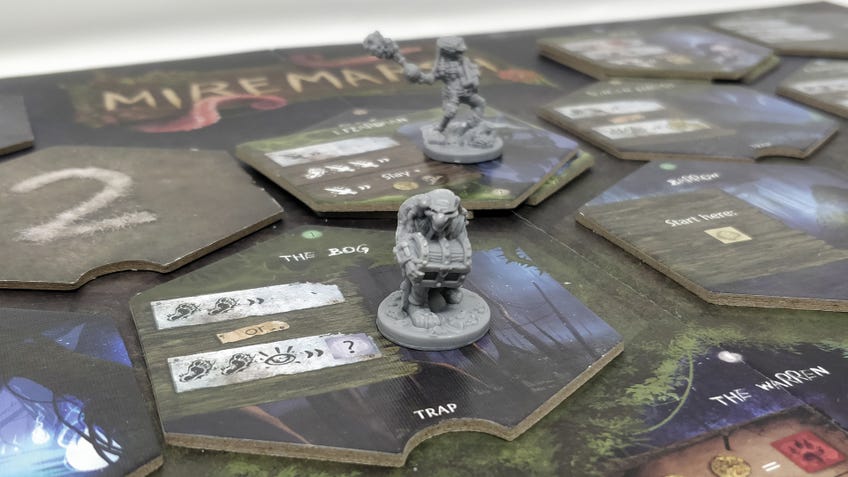
Even with this leniency, goblin death should still be taken seriously, as there is a limited supply of goblins in each game and players all take from the same pool. Once that pool runs out, any future goblin death is permanent - cleverly stopping players from deliberately bumping off goblins for an advantage.
The act of building up your goblin’s capabilities comes from obtaining temporary and permanent buffs from things like knick-knacks, pets, spells and additional dice. Though you can buy these from the trade tiles found in the centre of the board, the main way you get them is from completing optional challenges, such as trying to slay a monster - instead of just completing the compulsory challenge of surviving its initial attack - or attempting to gamble your way into getting three additional coins. Even buying things requires you to have gotten at least some gold already, which makes completing optional challenges essential if you want to get your hands on those buffs.
The feeling of confidence brought about by having oodles of additional dice or really strong permanent buffs is intoxicating.
Failing optional challenges results in death just as much as compulsory challenges do, but the allure of equipping your goblin and bulking them up for those difficult quests makes going for optional challenges worth the risk. Optional challenges need to be completed from top to the bottom as listed on the tile, meaning that if you want to get to the better rewards you’ll need to make it through the previous challenges first. You can choose to stop before any optional challenge, even if you’re halfway through those shown on the tile, but once you commit to any rerolls that’s it. The feeling of confidence brought about by having oodles of additional dice or really strong permanent buffs is intoxicating, and I found myself going for an optional challenge - and failing more than once - because of it.
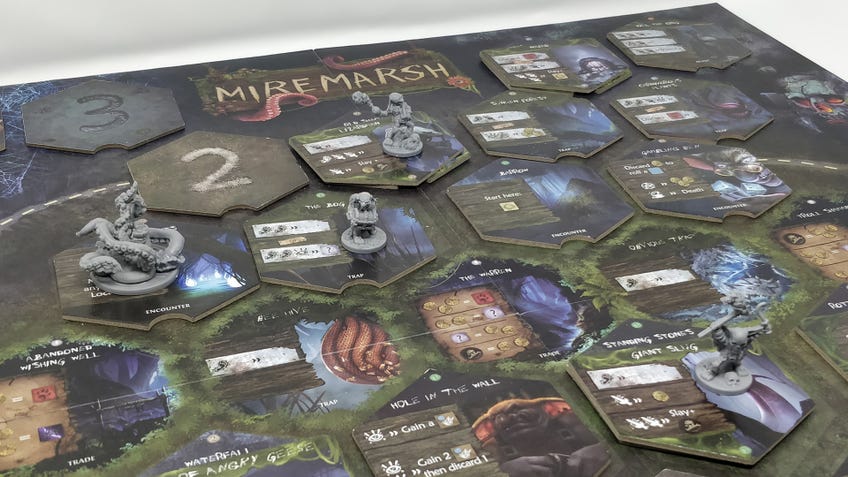
Miremarsh wants you to keep going, too. It eggs you on with the lure of loot, but also the fear of running out of perhaps the most precious resource in the entire game: fish. Ah, the sweet succulent taste of fish. Goblins love it and can’t live without it - literally - as players must pay one fish at the end of each turn or be permanently killed. But fish are really hard to find and players start out with a measly amount. This ever-depleting hourglass is a fantastic way of discouraging players from squatting on the same tiles for too long, forcing players to make a plan and work towards completing quests - or otherwise risk losing the game in an unsatisfying way.
Despite having played Miremarsh several times now, I’ve actually yet to see any player die from a lack of fish, but this is a point in the game’s favour rather than an unrealised mechanic. Permadeath or player elimination in board games only sucks because it’s often implemented poorly. Having players be knocked out too early means that people are sat there with nothing to do for the rest of the game, but Miremarsh avoids this by making its two paths to permadeath organically take a long time. Fish amounts are unlikely to vary wildly between players, and a goblin death usually has the effect of making players more cautious when attempting challenges - meaning that it’ll take time for all the goblins to run out.
Attempting to slay a monster to gain enough gold for the quest next door. Rolling a blue die with the potential reward of more funds but the risk of instant death. Taking on a challenge with just one fish remaining and scraping through to survive one more turn. The split-second of tension as the dice are rolled. This is the bread and butter of what makes Miremarsh fun. On the surface, it’s a board game that simply shouldn’t work - the artwork is bland, it’s incredibly luck-based and players can find themselves sitting out of the action - and yet against the odds it ends up being fun to play and memorable to boot. Every apparently mismatched element comes together in harmony to inform arguably Miremarsh’s strongest and most unlikely aspect: its ability to make dying fun.
